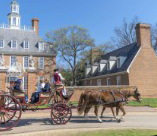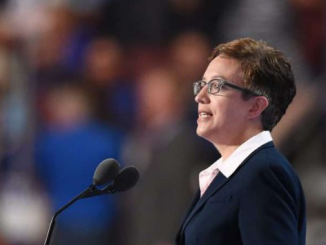
The New York Times’ 1619 Project selected Colonial Williamsburg, Virginia, as a filming location for its new Hulu docuseries. In doing so, creator Nikole Hannah-Jones sought to bolster her project’s most troublesome claim—the assertion that British overtures toward emancipation impelled the American colonists into revolution, ultimately securing an independent United States.
In the past three years, the Times has grappled with the fallout from Hannah-Jones’ assertion, including the revelation that it ignored its own fact-checker’s warnings against printing the charge. The Times tempered its language to apply to “some of” the colonists, only to see it reasserted by Hannah-Jones in her public commentaries. Later, a related line about the Project’s goal of replacing 1776 with a “true founding” of 1619 disappeared without notice from the Times’ website. The newspaper found itself in a balancing act between its writer’s uncompromising positions and the need to preserve credibility as it made a Pulitzer Prize bid with the series. But Hannah-Jones was not ready to abandon the claim at the center of her lead essay, and the first episode of the Hulu series makes that abundantly clear.
The scene opens in Williamsburg on the grounds of its reconstructed colonial Governor’s Palace, where Hannah-Jones joins University of South Carolina professor Woody Holton—one of a handful of heterodox historians who defended the 1619 Project’s original narrative. As the cameras pan across streets filled with historical re-enactors and tourists in front of restored colonial buildings, the pair take another stab at resurrecting the 1619 Project’s narrative about the American Revolution. The evidence that a British threat to slavery impelled Virginians—or perhaps “the colonists” at large, in Hannah-Jones’ imprecise phrasing—to revolt may be found in the November 1775 decree of John Murray, fourth earl of Dunmore, Virginia’s last Royalist governor. Facing the collapse of British rule, Dunmore announced that any enslaved male from a household in rebellion would be granted freedom in exchange for military service on the British side.
Dunmore’s decree made him the author of an “Emancipation Proclamation” of sorts, both Hannah-Jones and Holton contend. Their language intentionally evokes parallels to President Abraham Lincoln’s famous order freeing the slaves of the rebellious Confederacy in 1863. Prompted by Hannah-Jones’ questioning, Holton then recounts his version of the lesser-known events of some four score and eight years prior. “Dunmore issued that Emancipation Proclamation November 1775,” he explains, “and that Emancipation Proclamation infuriated white southerners.”
We see the visual power of the Hulu production at this moment as Holton lifts his finger, pointing at the Governor’s Palace, the centerpiece of the Colonial Williamsburg historical park. The camera quickly shifts to the recreated structure as he begins to speak. “Because this building is supposed to symbolize white rule over blacks, and now the guy inhabiting that building,” Dunmore, “has turned things upside down and is leading blacks against whites.” Hannah-Jones interjects, “So you have this situation where many Virginians and other southern colonists—they’re not really convinced that they want to side with the patriots. And this turns many of them towards the revolution. Is that right?” Holton answers without a flinch. “If you ask them, it did. The record is absolutely clear.”
The scene is an authoritatively delivered pronouncement set to stunning cinematography, but it’s also false history.
At the time of his decree, the real Dunmore had not set foot in Williamsburg in almost five months. His order, decreeing martial law in the colony and calling on slaves to enlist in a Royalist militia, came not from the governor’s residence but from a position of exile aboard the HMS William, a naval ship anchored off the coast of Norfolk, Virginia.
Dunmore abandoned the Governor’s Palace on June 8, 1775, amid signs that patriot militiamen were converging on Williamsburg to defend the House of Burgesses from a threatened power grab by the crown. The trouble began a few weeks earlier with a botched attempt by Dunmore to seize the colony’s gunpowder stores as a preemptive strike against revolutionary grumblings.
Indeed, when Dunmore fled the capital, he carried away a sizable staff of “servants” from the palace grounds and relocated them to Porto Bello, his sprawling plantation a few miles up the river. Yes, the 1619 Project’s designated agent of “emancipation” for the British crown was an enslaver himself. Dunmore encamped on a succession of warships anchored in the nearby York River, never to return to the building where Holton erroneously situated the decree. He occasionally took a barge over to the plantation house at Porto Bello to enjoy fine dining with his officers, served by his relocated slaves. But that ended as patriot militias gained control of the peninsula on which the property sat, and Dunmore withdrew to Norfolk. By November 7, 1775—the date of the order—he had long lost any semblance of control over the colony. The decree anticipated an unsuccessful campaign to regain a foothold in the colony. In retrospect, it was a desperate move to restore himself to power by inducing a slave revolt amid the already-unfolding revolution, rather than any true attempt to affect “emancipation” at large.
The inescapable progression of the timeline has always worked against Hannah-Jones’ narrative. Leaning heavily on Holton’s academic work, she asserts that Dunmore galvanized the southern colonies against Britain by imperiling their slave plantations and moving them into the revolutionary column. Holton’s commentaries in the docuseries signal his concurrence with this view insofar as it relates to Virginia, even as he stops short of Hannah-Jones’ blurry ascription of this motive to “the colonists” of the future U.S. at large. Yet as a matter of history, it collides with easily documented facts.
As the events around Williamsburg revealed, Dunmore’s order was a reaction to—not a cause of—a revolution already in full swing. The road to American independence began in Massachusetts over a decade earlier with men such as James Otis (incidentally, an early abolitionist) rallying against the crown under the banner of “no taxation without representation.” Virginia expressed solidarity with this cause long before Dunmore’s order.
In 1774, the House of Burgesses adopted a resolution of fasting to show their support for the people of Boston, then under a punitive edict from London in retaliation for its tax protests. A short time later, a group of leading Virginians including George Washington and George Mason signed the Fairfax Resolves, stating a long list of grievances against the crown (its promotion of the slave trade among them) and rejecting parliamentary control over the colonies. Patrick Henry, another Virginian, delivered his famous “Give me liberty, or give me death” speech in March 1775 before Dunmore even uttered a word about enlisting slaves. Washington himself would take command of the Continental Army on June 19, 1775, organizing his troops in New England after the Battle of Bunker Hill.
As his shipbound circumstances illustrated, the remnants of Lord Dunmore’s governorship amounted to little more than paper when he issued his decree that autumn. It is undoubtedly true that Dunmore’s order further inflamed an already-raging revolution, including nudging some slave-owning planters off the fence. But its sweeping martial law provision was likely the greater source of outrage. As Dunmore’s own financial interests illustrate, he had every intention of honoring the decree’s explicit exemptions for the human property of Royalist enslavers. None of these complicating details receive even the slightest amount of attention in the Hulu presentation from Williamsburg.
Hannah-Jones’ latest chronological mishap adds to a long list of errors that have plagued the 1619 Project. In this instance, it also speaks to a deeper underlying negligence around matters of basic fact. As a flashpoint of controversy since the 1619 Project’s inception, the claims about slavery in the American Revolution warranted careful attention. The docuseries offered Hannah-Jones yet another opportunity to clarify her case, ostensibly with the guidance of trained historians such as Holton. Instead, she pushed ahead, unaware of a timeline that any tour guide at the Governor’s Palace could have resolved for her.
Holton’s case is a bit more complicated, as his academic works, including his 2021 book Liberty Is Sweet, evince awareness of Dunmore’s shipbound circumstances after his June 1775 flight. In fact, Holton’s scholarly publications have attempted to walk a fine line around the 1619 Project that chafes with his ringing public endorsements of the same in popular media. A revealing footnote tucked inside Liberty Is Sweet states that Hannah-Jones “vastly exaggerates the size and strength of the British abolition movement” in the years before the revolution, dampening her attempts to use the 1772 anti-slavery Somerset case as an instigating cause of American independence. Yet as the docuseries shows, it is Holton who assigns particular significance to the filming location in Williamsburg, and it is Holton who points to the governor’s residence as the source of his own vastly exaggerated “Emancipation Proclamation.”
This peculiar convergence of factual error and cinematic misdirection comes with an ironic twist. If there are historical parallels to be drawn between Dunmore’s order and later events, it is not Lincoln’s Emancipation Proclamation but rather the desperate actions of his Confederate adversaries. In the waning days of the Civil War, Jefferson Davis authorized what became known as General Orders No. 14. The measure called for the “enlistment of colored persons” into the Confederate army, with provisions to accept any male slave “with his own consent and with the approbation of his master by a written instrument conferring, as he may, the rights of a freedman” in exchange for service. The Confederates paraded a handful of black companies on the streets of Richmond in late March 1865. Some of these troops were likely involved in a rearguard skirmish as Robert E. Lee’s army abandoned the city and made its fateful retreat toward Appomattox Courthouse.
The Confederates’ measure was no act of magnanimity by the slavers, but rather an exercise in desperation by a government on the precipice of collapse. Like Dunmore some 90 years before him, Davis lost his seat of power and found his forces in disarray. Most historians interpret his actions in this panicked context, not as some sudden change of heart on the central issue that sparked the Civil War.
And yet a parallel scenario from the American Revolution is now being touted as proof of a long-forgotten British antislavery crusade? We may look on in amazement, amusement, and disgust as the 1619 Project’s creator and its academic boosters attempt a peculiar rehabilitation of Dunmore—enslaver, plantation master, and Royalist autocrat—as a leading and even celebrated agent of emancipation.
* Article from: Reason


